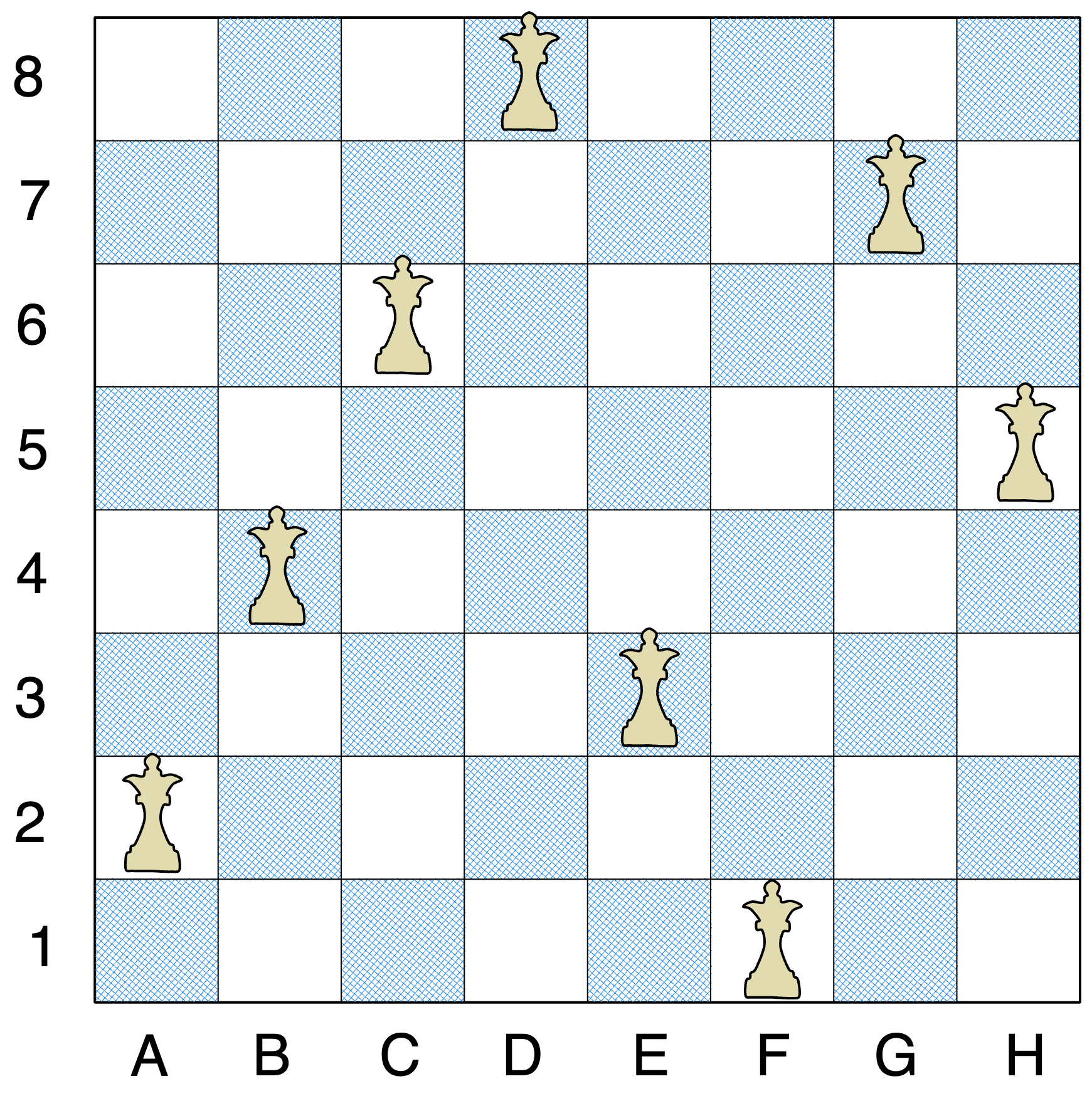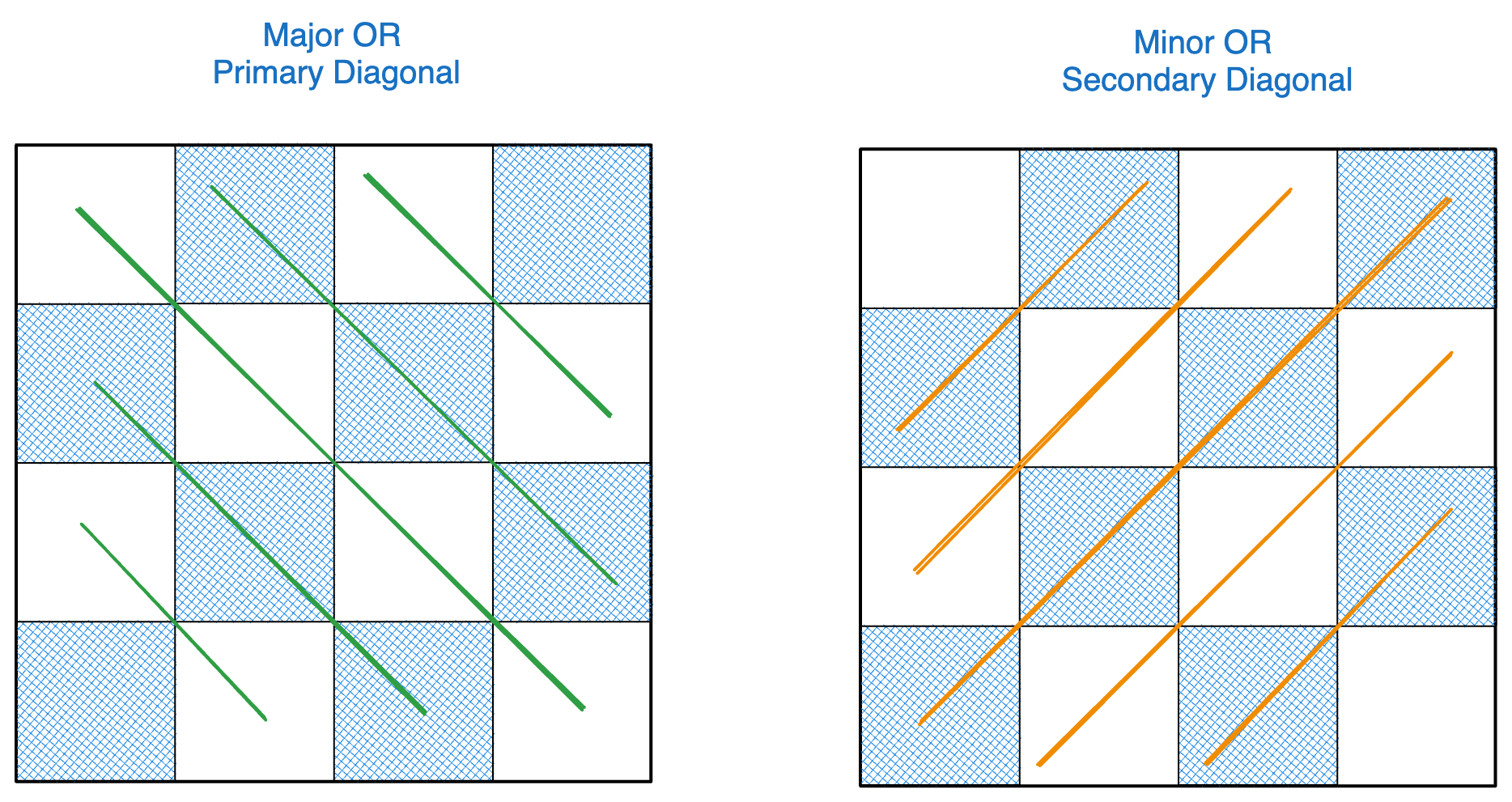N-Queens
Problem
The n-queens puzzle is the problem of placing n queens on an n x n chessboard such that no two queens attack each other.
Given an integer n, return all distinct solutions to the n-queens puzzle. You may return the answer in any order.
Each solution contains a distinct board configuration of the n-queens' placement, where 'Q' and '.' both indicate a queen and an empty space, respectively.
Definition of Attack
In chess, a queen can move as far as she pleases, horizontally, vertically, or diagonally. A chess board has 8 rows and 8 columns. The standard 8 by 8 Queen’s problem asks how to place 8 queens on an ordinary chess board so that none of them can hit any other in one move.(Source: http://www.math.utah.edu/~alfeld/queens/queens.html)
Here is one case for 8x8 board where queens dont attack each other.
Here is 1 possible solution for n-queen, for n = 8.

Examples
Example 1:

Input: n = 4
Output:
[
[".Q..", // Solution 1
"...Q",
"Q...",
"..Q."],
["..Q.", // Solution 2
"Q...",
"...Q",
".Q.."]
]
Explanation: There exist two distinct solutions to the 4-queens puzzle as shown above
Solution
Method 1 - Backtracking Using O(N^2) Space Matrix
The N Queen Problem is one of the best problem used to teach backtracking and of course recursion. Backtracking is a general algorithm which finds all complete solutions to a problem by building over partial solutions. In this process, the problem might reach to a partial solution which may not result into a complete solution. Such partial solutions are effectively rejected by the backtracking algorithm.
What Are Major & Minor Diagonals ?
With respect to a cell(i, j), the major diagonal contains all the cells [(i+2, j+2), (i+1, j+1), (i, j), (i-1, j-1), (i-2, j-2), (i-3, j-3)] till the limits of the board. On similar lines the minor diagonal contains all the cells [(i+2, j-2), (i+1, j-1), (i, j), (i-1, j+1), (i-2, j+2), (i-3, j+3)] and so on till the limits of the board.
Here is a pictorial representation for the same. The blue ones are major diagonals and the red ones are minor diagonals.

It is evident that we need a method which can check if the current cell is safe.
Algo:
- Place the queens column wise, start from the left most column
- If all queens are placed - return true and add the solution matrix.
- Let x be row and y be col, where we are placing queen Q. Every time we find a existing 'Q', 3 conditions need to be met before we can place a new 'Q' in the new column:
- no confict in columns : self explanatory as we put 'Q' col by col.
- no confict in rows :
x == i - no conflict in diagonals :
Math.abs(x-i) == Math.abs(y-j)
- If all the rows are tried and nothing worked, return false and print NO SOLUTION.
Here is the approach:
- Create a solution matrix of the same structure as chess board.
- Whenever place a queen in the chess board, mark that particular cell in solution matrix.
- At the end print the solution matrix, the marked cells will show the positions of the queens in the chess board.
Code
Java
public List<List<String>> solveNQueens(int n) {
char[][] board = new char[n][n];
for (int i = 0; i<n; i++) {
for (int j = 0; j<n; j++) {
board[i][j] = '.';
}
}
List<List<String>> ans = new ArrayList<List<String>> ();
dfs(board, 0, ans);
return ans;
}
private void dfs(char[][] board, int colIndex, List<List<String>> ans) {
if (colIndex == board.length) {
ans.add(constructSolution(board));
return;
}
for (int i = 0; i<board.length; i++) {
if (isSafe(board, i, colIndex)) {
board[i][colIndex] = 'Q';
dfs(board, colIndex + 1, ans);
board[i][colIndex] = '.';
}
}
}
private boolean isSafe(char[][] board, int x, int y) {
for (int i = 0; i<board.length; i++) {
for (int j = 0; j<y; j++) {
if (board[i][j] == 'Q' && (x + j == y + i || x + y == i + j || x == i)) {
return false;
}
}
}
return true;
}
private List<String> constructSolution(char[][] board) {
List<String> subAns = new LinkedList<String> ();
for (int i = 0; i<board.length; i++) {
String s = new String(board[i]);
subAns.add(s);
}
return subAns;
}
Code source - [4]
We can also write a bit verbose isSafe() function:
private boolean isValid(char[][] board, int x, int y) {
// check rows from top to bottom
for (int i = 0; i<board.length; i++) {
if (board[i][y] == 'Q') {
return false;
}
}
// check diag, top left to right bottom
for (int i = x - 1, j = y - 1; i >= 0 && j >= 0; i--, j--) {
if (board[i][j] == 'Q') {
return false;
}
}
// check diag, top right to left bottom
for (int i = x - 1, j = y + 1; i >= 0 && j<board[0].length; i--, j++) {
if (board[i][j] == 'Q') {
return false;
}
}
return true;
}
Method 2 - Backtracking Using O(N) Space Row
Solution matrix takes O(N^2) space. We can reduce it to O(N). We will solve it by taking one dimensional array and consider solution[1] = 2 as “Queen at 1st row is placed at 2nd column.
result[i]=j means queen at i-th row is placed at j-th column
Check if Queens placed at (x1, y1) and (x2, y2) are safe
x1==x2means same rows,y1==y2means same columns|x2-x1|==|y2-y1|means they are placed in diagonals.
public List<List<String>> solveNQueens(int n) {
List<List<String>> ans = new ArrayList<>();
dfs(0, new int[n], ans);
return ans;
}
public void dfs(int rowIdx, int[] row, List<List<String>> ans) {
int n = row.length;
if (rowIdx == n) {
ans.add(constructSolution(row));
return;
}
for (int c = 0; c < n; c++) {
boolean ok = true;
row[rowIdx] = c;
for (int r = 0; r < rowIdx; r++) {
if (row[rowIdx] == row[r] || rowIdx - row[rowIdx] == r - row[r] || rowIdx + row[rowIdx] == r + row[r]) {
ok = false;
break;
}
}
if (ok) {
dfs(rowIdx + 1, row, ans);
}
}
}
public List<String> constructSolution(int[] row) {
int n = row.length;
List<String> subAns = new ArrayList<>(row.length);
for (int i = 0; i < n; i++) {
StringBuilder line = new StringBuilder();
for (int j = 0; j < n; j++)
if (j == row[i]) {
line.append("Q");
} else {
line.append(".");
}
subAns.add(line.toString());
}
return subAns;
}
Analysis for N Queen Problem
- Time Complexity:
O(N! * N) - Space Complexity:
O(N^2)OR O(N) depending on solution picked.
Space complexity
For this algorithm it is O(N). The algorithm uses an auxiliary array of length N to store just N positions.
Time complexity
- The isSafe method takes O(N) time as it iterates through our array every time.
- For each invocation of the placeQueen method, there is a loop which runs for O(N) time.
- In each iteration of this loop, there is isSafe invocation which is O(N) and a recursive call with a smaller argument.
If we add all this up and define the run time as T(N). Then T(N) = O(N2) + N*T(N-1). If you draw a recursion tree using this recurrence, the final term will be something like n3+ n! O(1). By the definition of Big O, this can be reduced to O(n!) running time. Let me know in comments if you are not able to derive the n! from the recurrence, I will try to draw the recursion tree.